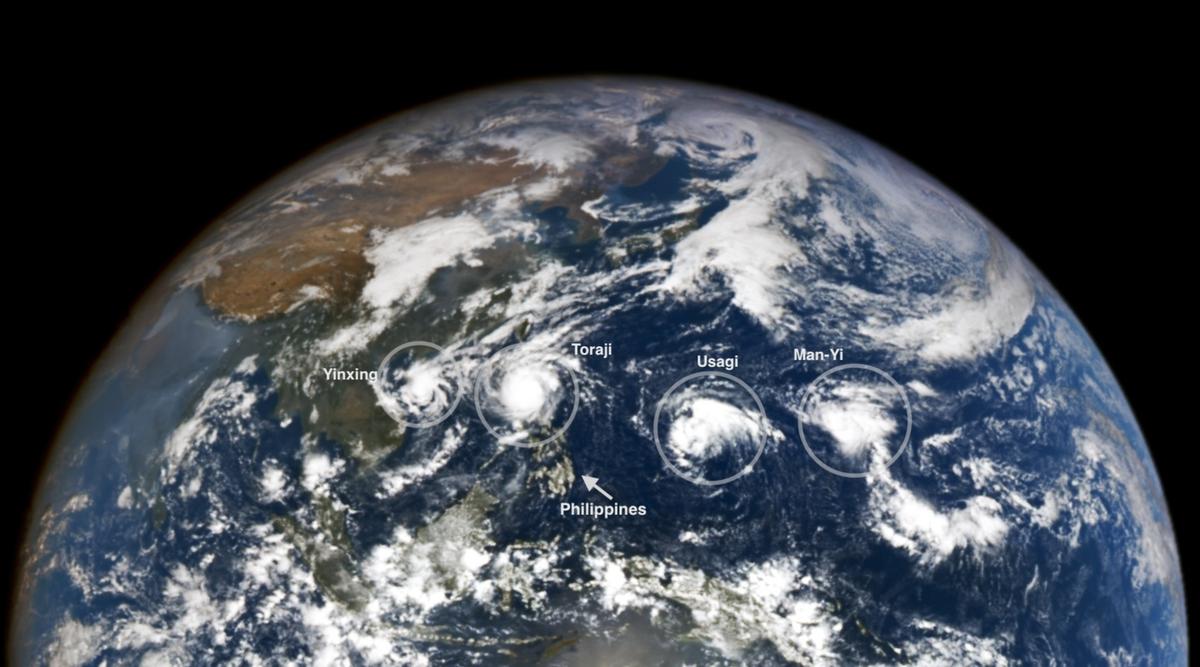Camarines, Philippines —(Map)
Over the last month, the Philippines has been hit by six major storms, including five typhoons. The latest storm, Super Typhoon Man-yi, struck on Saturday night, forcing hundreds of thousands of people from their homes and causing serious damage.
The Philippines is made up of around 7,500 islands in the Pacific Ocean. Every year, the country gets hit by about 20 storms or typhoons. Most people in the Philippines have learned to expect storms, but the last few weeks have been challenging even for the best-prepared people.
In late October, the country was hit by Tropical Storm Trami and Typhoon Kong-Rey. Those storms affected millions of people, forced nearly 300,000 from their homes, and left roughly 150 people dead.
Following that, in the last eleven days alone, the country has been hit by four more typhoons.

(Source: NASA Earth Observatory [Public domain], via Wikimedia Commons.)
The first storm this month, Typhoon Yinxing, made landfall on November 7, with speeds of up to 110 mph (175 kph). It dropped massive amounts of rain on areas of the Philippines, causing landslides. Four days after that, the country was hit by Typhoon Toraji.
On November 14, the Philippines was hit by another powerful storm – Typhoon Usagi, which hit with 130 mph (210 kph) winds.
Without giving the islands a chance to recover, Super Typhoon Man-yi showed up just two days later. Man-yi first hit the Philippines in Catanduanes on Saturday night. It brought winds of up to 150 mph (240 kph). As the storm moved on, it crossed open water and hit land again on the main island of Luzon.
😕
This image has not been loaded because of your cookie choices. To view the content, you can accept 'Non-necessary' cookies.
Super Typhoon Man-yi hit the Philippines on Saturday night, bringing winds of up to 150 mph (240 kph), heavy rain, and flooding. The storm knocked down houses, and the rain triggered landslides. In the northern Philippines, hundreds of homes were flooded after a river overflowed (above).
Man-yi brought strong winds, heavy rain, and flooding. The storm knocked down houses, and the rain triggered landslides, which have killed at least 8 people. In the northern Philippines, hundreds of homes were flooded after a river overflowed.
The province of Camarines is one of the places that was hit the hardest. All through the area, houses are damaged, the electricity is out, and there is no running water. A government worker in Camarines said that the people had “not recovered from the previous storms when the super typhoon hit.”
The steady stream of storms has left the country in shock. In all, the storms have affected about 9 million people, causing damage to roads, farms, and buildings. Close to 8,000 homes have been damaged or destroyed. Currently, around 700,000 people have been forced to leave their homes, and are staying in emergency shelters or with relatives.
😕
This image has not been loaded because of your cookie choices. To view the content, you can accept 'Non-necessary' cookies.
The province of Camarines is one of the places that was hit the hardest: houses are damaged, the electricity is out, and there’s no running water. Currently, around 700,000 people have been forced from their homes, and are staying in emergency shelters or with relatives. Above, people at an emergency shelter in Camarines.
The storm knocked out power in over 100 areas, and left many people without enough food or drinking water. Many areas are also in need of building supplies to fix their homes.
The damage in the Philippines is so serious and so widespread that it will take time to recover. Several countries have offered help, including the US, Singapore, Malaysia, Indonesia, and Brunei. The US has offered $1 million and says that US soldiers in the country will also help out.
For now, at least, the country will have a little time to recover. Currently, no major storms appear to be headed toward the Philippines.
😕
This map has not been loaded because of your cookie choices. To view the content, you can accept 'Non-necessary' cookies.
